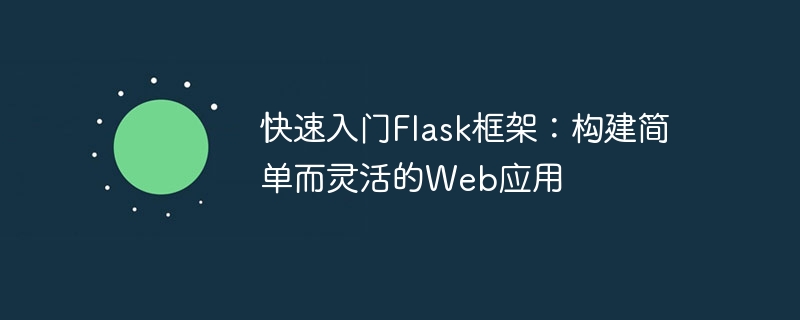

Quick Start with Flask Framework: Build Simple and Flexible Web Applications
Flask is a lightweight Web application framework based on the Python programming language. It is simple and flexible, allowing developers to quickly build web applications. Flask provides core functions and is also an extensible framework that can achieve more functions through plug-ins. This article will introduce the quick start of the Flask framework and provide readers with a deeper understanding through specific code examples.
1. Flask installation and environment configuration
First, we need to install Flask. Installation can be easily done using the pip command. Open a command line window and enter the following command:
pip install flask
After the installation is complete, we can start creating a basic Flask application.
2. Create a simple Flask application
First, create a Python script file in the project folder and name it app.py. Open the file and enter the following code:
from flask import Flask
app = Flask(__name__)
@app.route('/')
def hello():
return 'Hello, Flask!'
if __name__ == '__main__':
app.run()The above code creates a basic Flask application. First, we introduced the Flask module and instantiated a Flask object. The next @app.route('/') decorator defines a route that triggers the hello function when the root directory is accessed. This function returns a simple string. The final app.run() starts the application.
3. Run the Flask application
After saving the app.py file, we can run the Flask application through the following command:
python app.py
The command line will display the running application URL address. Enter the address in the browser and you will see the displayed string "Hello, Flask!". This is a running Flask application.
4. Processing dynamic routing
Flask also provides dynamic routing, which can return different results according to different URL parameters. We modify the app.py file and add the following code:
@app.route('/user/<username>')
def show_user(username):
return 'Hello, %s!' % usernameThe above code defines a new route: /user/username. When accessing this route, the show_user function will be called. This function accepts a parameter username and returns a string with the parameter value inserted into the string. For example, when accessing /user/John, the page will display "Hello, John!".
5. Templates and static files
Flask supports using templates to render dynamic pages. We can use Jinja2 template engine to achieve this. First, create a folder named templates under the project folder, and then create a template file named index.html under the folder. The content of the file is as follows:
<!DOCTYPE html>
<html>
<head>
<title>Flask Demo</title>
</head>
<body>
<h1>Hello, {{ name }}!</h1>
<p>This page is rendered by Flask.</p>
</body>
</html>Next, we modify the app .py file, add the following code:
from flask import render_template
@app.route('/hello/<name>')
def hello_name(name):
return render_template('index.html', name=name)The above code defines a new route: /hello/name. This route will call the hello_name function and use the render_template function to render the template file index.html. {{ name }} in the template file will be replaced with the value of the passed parameter name.
6. Processing form data
In web applications, processing form data submitted by users is a very common scenario. Flask provides a Request object to obtain form data. We modify the app.py file and add the following code:
from flask import request
@app.route('/login', methods=['GET', 'POST'])
def login():
if request.method == 'POST':
username = request.form['username']
password = request.form['password']
return 'Username: %s, Password: %s' % (username, password)
else:
return '''
<form method="post" action="/login">
<input type="text" name="username" placeholder="Username"><br>
<input type="password" name="password" placeholder="Password"><br>
<input type="submit" value="Login">
</form>
'''The above code defines a route/login, which supports both GET requests and POST requests. When the request method is POST, obtain the form data through request.form and return the data. When the request method is GET, a simple login form is displayed.
7. Summary
This article briefly introduces how to quickly get started with the Flask framework. By installing Flask and running a basic application, we understand the core concepts and basic usage of Flask. We then covered the use of dynamic routing, templates, and static files, as well as ways to handle form data. Through these specific code examples, I believe readers can have a deeper understanding of the Flask framework and be able to use it to build simple and flexible web applications in actual development.
The above is the detailed content of Quick Start with the Flask Framework: Build Simple and Flexible Web Applications. For more information, please follow other related articles on the PHP Chinese website!
 How to make charts and data analysis charts in PPT
How to make charts and data analysis charts in PPT
 Android voice playback function implementation method
Android voice playback function implementation method
 AC contactor use
AC contactor use
 The difference between vscode and visual studio
The difference between vscode and visual studio
 The difference between Java and Java
The difference between Java and Java
 Introduction to hard disk interface types
Introduction to hard disk interface types
 nagios configuration method
nagios configuration method
 How to delete a folder in linux
How to delete a folder in linux




